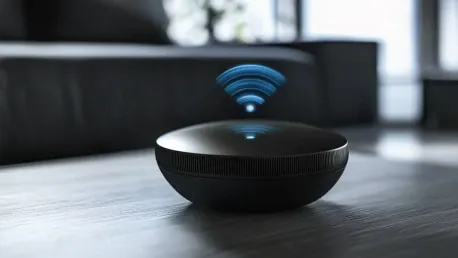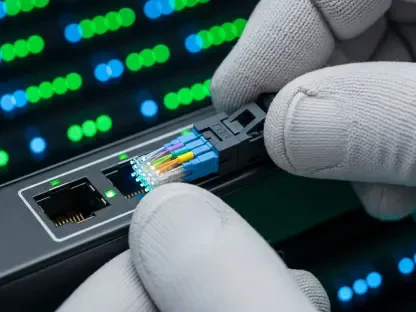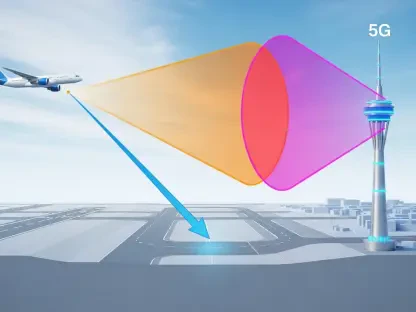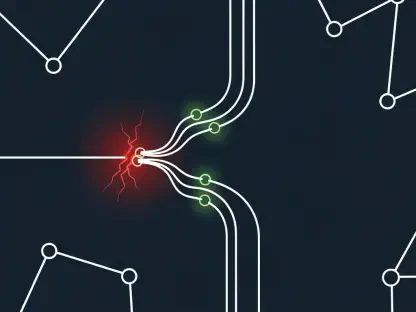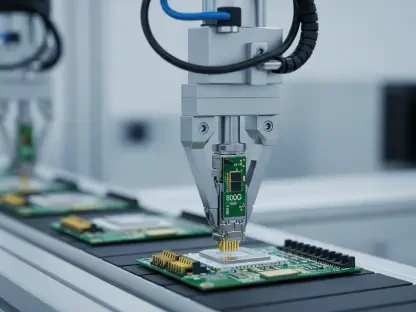CES 2025 concluded this week, generating substantial buzz around Wi-Fi technology, particularly the advancements in Wi-Fi 6E, Wi-Fi 7, and Wi-Fi HaLow. The tech event, renowned for showcasing cutting-edge developments across various domains, highlighted several significant strides in the Wi-Fi sector, reflecting its role in shaping future connectivity solutions.
Emergence and Impact of Wi-Fi 7
Rapid Adoption and Device Integration
Since the certification of Wi-Fi 7 roughly a year ago, the industry has witnessed considerable implementation across devices. As of October 2024, about 33 smartphone models and numerous high-end laptops are equipped with Wi-Fi 7 capabilities. Wi-Fi 7 is designed to exploit vast expanses of unlicensed spectrum within the 6 GHz band, initially penetrated by Wi-Fi 6E, to deliver a peak data rate of up to 46 Gbps. This signifies a substantial leap from its predecessors, reinforcing the capacity for superior data throughput and network efficiency.
The rapid adoption of Wi-Fi 7 is a testament to its transformative capabilities, allowing manufacturers to offer faster, more reliable connectivity solutions. The technology has not only improved existing devices but also paved the way for new innovations across various sectors. As more devices incorporate Wi-Fi 7, users can expect significant enhancements in their daily wireless experiences, ranging from faster downloads to smoother streaming and more stable connections.
Enhanced Connectivity and User Experience
The transforming function of 6 GHz Wi-Fi is driven by the increasing reliability and deterministic nature of the latest Wi-Fi iterations. A report by OpenSignal revealed that users spend between 77% and 88% of their screen-on time connected to Wi-Fi, underscoring its critical role in daily operations. Enhanced attributes, such as 320 MHz channels and Multi-Link Operation (MLO), are facilitating more robust and consistent connectivity, supporting advanced applications such as extended reality (XR) both in domestic and enterprise environments. This underlines the growing relevance of advanced Wi-Fi technologies in supporting intensive, high-bandwidth usages.
These advancements not only enhance the user experience but also enable the development of new applications that were previously impractical due to bandwidth limitations. For instance, extended reality (XR) technology relies heavily on high-speed, low-latency connections, which Wi-Fi 7 can provide. This makes Wi-Fi 7 an essential component in the future of immersive digital experiences, both for personal use and in professional settings.
Key Highlights from CES 2025
Google and MediaTek’s Collaboration on Home Ecosystem Chipset
Google and MediaTek announced the development of a chipset, MT7903, for the Google Home ecosystem. The chipset integrates tri-band Wi-Fi 6E, Bluetooth 6, and IEEE 802.15.4/Thread radios to promote Thread, an IPv6-based, low-power mesh IoT networking technology. Additionally, it supports the Matter standard, aiming to improve IoT security, interoperability, and cross-manufacturer compatibility. Sampling of this chipset is expected to begin in the first half of 2025.
The collaboration between Google and MediaTek is a significant step towards creating a more connected and interoperable smart home environment. The integration of tri-band Wi-Fi 6E and Bluetooth 6 ensures that the chipset will provide robust, high-speed connectivity for a wide range of devices. By supporting the Matter standard, the chipset also addresses one of the biggest challenges in the IoT space: ensuring that devices from different manufacturers can work together seamlessly and securely.
Morse Micro’s Wi-Fi HaLow Chip Introduction
Morse Micro unveiled its second-generation Wi-Fi HaLow SoC, the MM8108-EK#9, featuring enhanced range, throughput, and power efficiency. The chip offers data rates up to 43.33 Mbps utilizing sub-GHz 256-QAM modulation over an 8 MHz bandwidth. This positions it as an ideal solution for diverse applications in agriculture, mining, industry, and urban environments, driven by improved spectrum efficiency and low-power operation. Morse Micro’s CEO, Michael De Nil, emphasized the transformative potential of this chip in the IoT market.
The introduction of Morse Micro’s second-generation Wi-Fi HaLow SoC represents a significant advancement in IoT technology. By offering enhanced range and power efficiency, the MM8108-EK#9 can effectively cater to the needs of various industries that require long-range connectivity with minimal power consumption. This is particularly important for applications in remote or hard-to-reach areas, where traditional Wi-Fi solutions may fall short. The chip’s ability to provide reliable, low-power connectivity makes it a valuable asset for the future of IoT deployments.
Intel’s vPro AI PC Platform with Wi-Fi 7
Integration and Speed Benefits
Intel integrated Wi-Fi 7 into its AI PC processor platforms, notably the Intel Core Ultra Series 2. Intel’s website detailed the substantial speed benefits of Wi-Fi 7, which can reach approximately 5.8 Gbps—2.4 times faster than Wi-Fi 6/6E. This uptick in speed facilitates high-quality 8K video streaming and significantly reduces large file download times, showcasing the enhanced user experience potential.
The integration of Wi-Fi 7 into Intel’s vPro AI PC platform is a game-changer for modern computing. With its impressive speed capabilities, Wi-Fi 7 enables users to perform data-intensive tasks more efficiently, whether it’s streaming high-definition video, downloading large files, or engaging in real-time collaboration. This marks a significant step forward in the evolution of AI-driven PC platforms, as it enhances their ability to provide seamless, high-performance connectivity.
Enhanced User Experience
The integration of Wi-Fi 7 into Intel’s vPro AI PC platform underscores the importance of high-speed connectivity in modern computing. The ability to stream 8K video and download large files quickly is a game-changer for both consumers and professionals. This development highlights the ongoing efforts to improve user experience through advanced Wi-Fi technology.
As Wi-Fi 7 becomes more widely adopted, users can expect a significant improvement in their overall computing experience. The technology’s enhanced speed and reliability will allow for more efficient workflows, whether users are working remotely, gaming, or simply browsing the internet. By prioritizing user experience, Intel and other industry leaders are paving the way for a future where high-speed, reliable connectivity is the norm.
TP-Link’s Mesh Wi-Fi 7 Solutions
Whole Home Mesh System
TP-Link introduced the Deco BE68 Whole Home Mesh Wi-Fi 7 system, delivering speeds up to 14 Gbps across 8,100 square feet and supporting up to 200 devices. The solution features various port configurations to ensure high-speed wired connections and seamless coverage, making it suitable for streaming, gaming, and more.
The introduction of TP-Link’s Deco BE68 Mesh Wi-Fi 7 system is a significant advancement in home networking technology. With its ability to cover a large area and support multiple devices, the system ensures that users can enjoy fast and reliable internet connectivity throughout their homes. This is particularly important in today’s world, where more people are working and learning from home and require consistent, high-speed internet access.
Outdoor Connectivity Solutions
Additionally, TP-Link announced outdoor mesh systems (Deco BE65-Outdoor and Deco BE25-Outdoor) to address growing outdoor connectivity needs, promising a cohesive indoor-outdoor network. These solutions are designed to provide robust and reliable connectivity in outdoor environments, ensuring seamless internet access across large areas.
The introduction of outdoor mesh systems by TP-Link highlights the growing demand for reliable internet connectivity in outdoor spaces. Whether it’s for streaming media in the backyard, supporting outdoor security cameras, or providing connectivity for smart outdoor appliances, the new systems ensure that users can enjoy a consistent and reliable connection both indoors and outdoors. This marks an important step forward in creating comprehensive, all-encompassing home network solutions.
ASUS ROG Rapture GT BE-98 – World’s First Quad-Band Wi-Fi 7 Router
Advanced Features and Performance
ASUS unveiled its quad-band Wi-Fi 7 gaming router, the ROG Rapture GT BE-98. This device incorporates critical Wi-Fi 7 features like MLO, 4kQAM, and 320 MHz channels, achieving peak data rates of 25 Gbps. Its dual-feeding antennas enhance coverage and signal strength, ensuring robust connectivity for gaming and other demanding applications.
The launch of ASUS’s ROG Rapture GT BE-98 represents a significant milestone in the development of gaming routers. With its advanced features and exceptional performance capabilities, the router is designed to meet the demands of the most intense gaming sessions, ensuring that players can enjoy a seamless and immersive experience. The incorporation of Wi-Fi 7 into the router highlights the potential of the technology to revolutionize the gaming industry, providing faster, more reliable connections for gamers worldwide.
The quad-band Wi-Fi 7 router from ASUS underscores the importance of robust, high-speed connectivity in modern gaming. As online gaming continues to grow in popularity, the demand for reliable, low-latency connections has never been higher. By delivering exceptional performance and coverage, the ROG Rapture GT BE-98 sets a new standard for gaming routers, paving the way for future innovations in the space.
Additional Announcements
Several other notable Wi-Fi 7-related products were also revealed:
- BARROT introduced Wi-Fi 7, LE audio, and channel sounding solutions.
- Netgear launched a Wi-Fi 7 Orbi mesh system.
- Lenovo showcased its Wi-Fi 7 compatible Legion Pro 5 laptop.
Analysis and Consensus
The overarching theme from CES 2025 is the significant progression of Wi-Fi technology, with Wi-Fi 7 at the forefront, offering unprecedented speeds and connectivity reliability. The innovations highlighted emphasize the ongoing effort to bridge higher performance and broader coverage, catering to both consumer and industrial needs.
Wi-Fi’s evolving role, backed by substantial integration in high-end devices and increasingly dependable performance, points to its central place in enabling advanced applications like extended reality. This shift aligns with trends toward more immersive and bandwidth-intensive digital experiences, both at home and in business settings.
The CES 2025 innovations clearly demonstrated a consensus viewpoint: Wi-Fi technology development is pivotal in driving forward IoT capabilities, overall network efficiency, and user experience. This perspective is underpinned by collaborative efforts among industry giants like Google, MediaTek, and Intel, signaling a robust ecosystem focused on leveraging next-generation Wi-Fi standards.
Conclusion
CES 2025 wrapped up this week, generating significant excitement and interest around Wi-Fi technology, particularly with advancements in Wi-Fi 6E, Wi-Fi 7, and Wi-Fi HaLow. This tech event, which is well-known for showcasing the latest innovations across various fields, put a spotlight on numerous breakthroughs in the Wi-Fi sector. These advances underscored the pivotal role of Wi-Fi in shaping the future of connectivity solutions, promising faster speeds, greater efficiency, and more robust performance. Attendees and exhibitors alike focused on how these new Wi-Fi standards will not only enhance our daily internet usage but also support the burgeoning Internet of Things (IoT) ecosystem. Wi-Fi 6E, with its access to the 6 GHz band, promises to alleviate congestion and improve network performance. Wi-Fi 7’s potential to achieve multi-gigabit speeds offers a glimpse into the future, where uninterrupted, high-speed connections become the norm. Meanwhile, Wi-Fi HaLow, designed for long-range, low-power communication, aims to revolutionize IoT applications.
